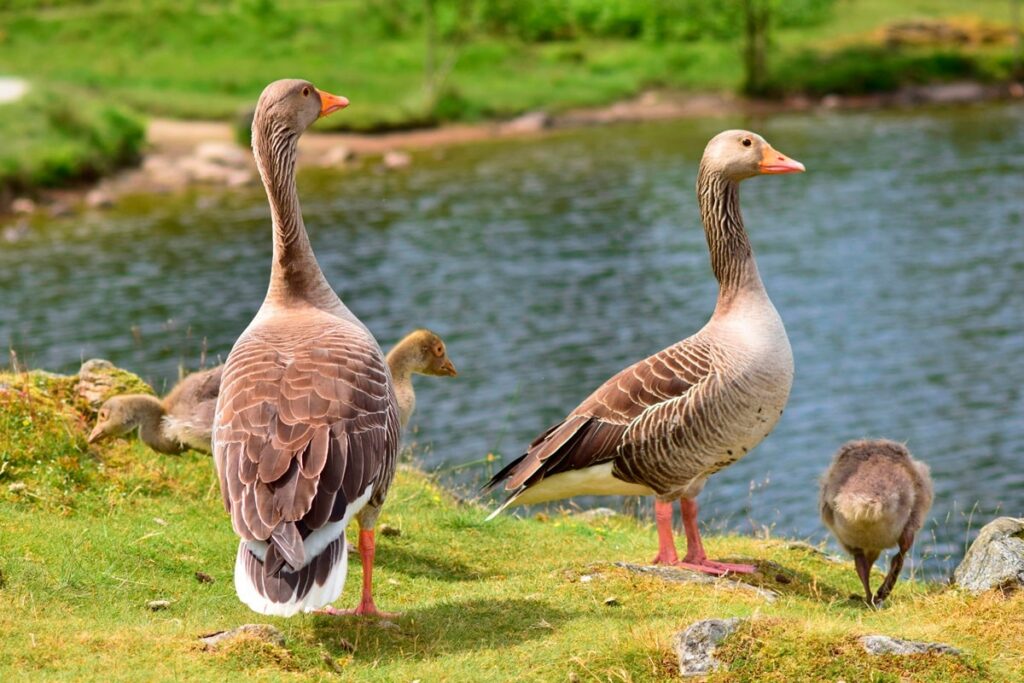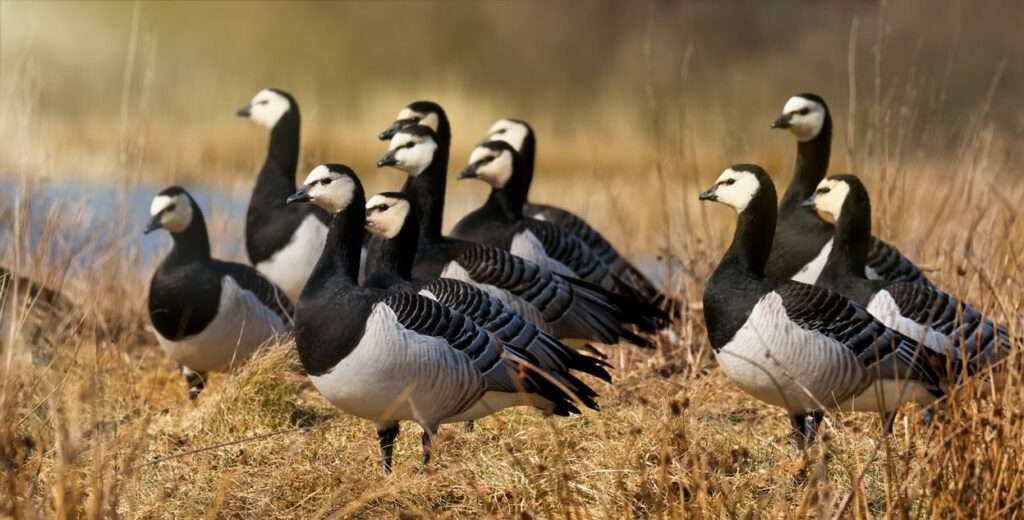Geese are species of waterfowl in the family of Anatidae, found in waterbodies worldwide, including rivers, lakes, ponds, reservoirs, bays, and oceans. Two genera of birds in the Anatidae family contain all of the true geese, seven of which live in North America.
Most wild Canada Geese can live an average of 10 to 25 years, depending on where they live. Domestic geese can live an average of 20 years or more if they are well-cared for, protected from predators, and fed a healthy diet with balanced nutrition.
The lifespans of other geese are not as well understood because they are not as well researched as Canada Geese. For example, Snow Geese may live more than 15 years, Greylag Geese may live more than 20 years, and Barnacle Geese can live over 28 years.

How Long Do Domestic Geese Live?
Domestic geese live on farms, zoos, and parks worldwide. Farmers raise them as food or as a source of eggs. In zoos and park properties, they provide an aesthetically pleasing cacophony of life in the background on public waters.
Farmers, zoo staff, and park workers care for these pampered pets and livestock and ensure the animals are well-fed with the proper nutrition. These birds do not have to worry about predators and enjoy a relatively carefree existence unless they provide food for people.
As a result of the long-term care domestic geese receive, they can live for around 20 years. With great care, however, some domestic geese have survived for over 40 years, although this maximum age is uncommon for some domestic goose breeds.

How Long Do Wild Geese Live?
Wild geese have to overcome many challenges throughout their lifespan. They must avoid predators, disease, starvation, and extreme weather events that might kill them before they can find a mate and produce offspring.
Geese begin courting and breeding at age two. During the first year of their lives, they are most at risk of dying from predation and starvation. Once they reach adulthood, they are far less susceptible to predation.
Although the longevity of the various goose species is variable, wild geese can live for more than 20 years. In addition, as geese age and gain experience breeding, they become better at producing more offspring that survive to adulthood.

What Kills Geese?
Not many animals are big enough to prey on full-grown geese, so when they grow to adult size, they typically live many years. The most significant predators of adult geese are humans, who harvest more than two million geese annually in the United States.
In addition to hunting, adult geese are susceptible to several Avian diseases, including Botulism, Cholera, Vacuolar Myelinopathy, and Influenza. Because many of these diseases are highly contagious, diseased individuals can rapidly infect many other birds before dying.
Goose eggs and goslings are easy prey for many predators. The predators of goose eggs vary depending on the location geese are nesting. Geese nesting in the Arctic must protect their eggs from Arctic foxes, Arctic skuas, glaucus gulls, and common ravens.
These voracious Arctic predators eat between 19 and 88% of the annual goose nest production. In years when lemming populations explode, Arctic predators consume more lemmings and fewer goose eggs, allowing more young geese to survive to adulthood.
Other common predators on goose nests throughout their range include snakes, rats, coyotes, bears, bald eagles, wolves, mink, foxes, owls, crows, magpies, gulls, northern harriers, and river otters. When one of these predators raids a goose nest, that nest often fails.
If predators raid a nest early enough in the breeding season, the breeding pair will attempt to build a new nest and raise a brood before the end of the breeding season. If the breeding pair loses all their offspring too late in the season, they will wait and try again next year.
Once goslings leave the nest and spend most of their time swimming, they are less susceptible to predation from terrestrial predators. However, until goslings grow large enough, they are preyed on by many large fish, turtles, otters, raccoons, snakes, and raptors.
What Happens When a Goose Dies?
Geese typically mate for life. Because individuals can live more than 20 years in the wild, these breeding pairs can survive for many years. When one member of the breeding pair dies, the remaining bird will find a new mate.
If one of the birds in a breeding pair dies near the beginning of the nesting season, the remaining bird will attempt to find a new mate and produce offspring before the breeding season ends.
When a female loses her mate after they have built a nest and laid eggs, she will not have anyone to support her in defending the nest. If she cannot find a new mate quickly, she may abandon the nest in search of a new mate because she cannot protect the nest and find food.
The geese that lose their mate later in the breeding season will likely abandon any further attempts to breed until the following year. Instead, they will leave the breeding grounds and join a flock of unmated geese during molting.
What Is the Oldest Goose?
Geese can live for decades, especially if they live in places without extreme weather events, excessive pressure from predation, few diseases, and plenty of food to eat and feed their offspring.
The oldest goose on record was 49 years and eight months old. This pet goose named George lived in the United Kingdom before its death in 1976. This goose still holds the Guinness World Record for his longevity.
Although wild geese do not reach ages that old, some can survive for more than three decades. The oldest Barnacle Goose on record was 30 years old, the oldest Greylag Goose was 31, the oldest snow goose was 30, and the oldest Canada Goose was 33.
